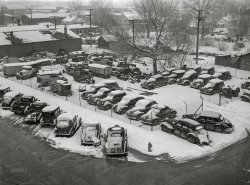
MAY CONTAIN NUTS

Search Shorpy
SHORPY ART

Framed or unframed, desk size to sofa size, printed by us in Arizona and Alabama since 2007. Explore now.
Join and Share
Ad-Free Shorpy
Shorpy is funded by you. Patreon contributors get an ad-free experience.
Learn more.

Recent comments
- Illuminate us
- I remember it well
- I can't prove it
- Complicated then, forgotten now
- Bryan-Stevenson
- Skinny is as skinny does
- How do you rest in peace
- Riding the footboards
- Alas, hidden from view
- Baldwin Diesels
- Exclusive pump
- Bananas, Oysters and Smokey Joe
- Details, Details
- What's that building to the left of the tower?
- Coal Barges
- Bromo-Seltzer
- Inner harbor
- The Basin
- What a headache!
- Giant stepladder?
- Yeah, it was cold
- Love those coats
- Link & Pin Days Remnant
- Baldwin 62303
- Baldwin VO-1000
- Cold
- No expense spared
- Tough Guys
- What's your hurry, where's your hat?
- Sheriff's Signature
Member Photos
The Shorpy
Print Emporium
Print Emporium
Search Shorpy
Search results -- 30 results per page
- Piano Man: 1941
- ... Hand Mission. Portsmouth, Virginia." Acetate negative by John Vachon for the Farm Security Administration. View full size.
Picture on ... Posted by Dave - 02/10/2021 - 10:06pm -
![Piano Man: 1941 March 1941. "Mission pianist in his room at the Helping Hand Mission. Portsmouth, Virginia." Acetate negative by John Vachon for the Farm Security Administration. View full size.
Picture on the far wallI wonder who that is in that picture. It looks like it could be an entertainer. Who does the Mission pianist idolize? Any Shorpy fans have any ideas?
Call me crazybut I am always amazed at photos like this, of the decrepit state of the walls, and in this case even the mantelpiece. Had these folks never heard of paint? Were they so destitute that they could not afford even a single coat, or a layer of wallpaper? Or were they too lazy, or did they simply not care? The ugliness had to have threatened to suck the life right out of them. I'll wager that even the goldfish would have agreed with me. And don't get me started on that welter of wires.
"Outside these walls"Hope our subject lightened up a bit when he played for the audience.
Rings a bellThe image above our man’s right shoulder—man and woman in a field—is Millet’s “Angelus,” which depicts farm laborers stopping their work to pray at the 6 p.m. ringing of the bells.
Speaking of time, the unsynchronized clocks on the mantel fit right into the general decrepitude.
Re: crazyNow that I own my house (an old one), I do fix-it work non-stop. As a rental tenant, though, I never did a thing – I figured it was the landlord’s responsibility. What I didn’t realize in my younger years was that, even though I didn’t own my home back then, I would have improved my living conditions immeasurably had I painted or gardened, despite the fact that I was maintaining someone else’s property. All the work put into my rented place by myself would have benefited myself, but I didn’t understand this concept. With regard to the piano man’s place, it needs more than a lick of paint -- some preliminary plaster work is definitely required.
On the far wallThe picture looks like it may be Dickie Powell.
Early Power BarWe plug our scanners, computers, printers, etc. into a power bar with a circuit breaker. The octopus wiring setup in this photo might be considered an earlier version of the same thing. Having moved into my 1928 home in 1977 that still had its original 30 amp 115 volt panel with fuses, I soon learned which electrical appliances could not be plugged in simultaneously. Within three years the house was upgraded to a 125 amp system with 115 and 240 volts available.
I might also note that many of John Vachon's photos of people bear a resemblance to those of Diane Arbus in the 1960s.
Living SimplyHe probably lives in such spartan conditions because he works at the mission for nothing, or next to nothing. Believe it or not, there used to be a time when people did church work because they loved people and cared about them. I would hazard a guess that the modern-day 'teaching pastor' or 'praise team' member wouldn't be caught dead living in a hovel like this so that they could have the privilege to minister to the needs of their fellow man!
Way Down On The ListYes, we see a lot of places we wouldn't want to live on Shorpy. I think it's driven by the everyday need to acquire basic necessities to survive back then (and for a lot of folks today too). The furnishings are nice and the place looks clean.
The stove fluecaught my eye right away. I wonder how hard it was to get a draft going. While the flue pipe may radiate a lot of trapped heat, getting that heat to go down and then up is no easy task. All I can see is smoke billowing from the door each time it's stoked. I look at the walls and wonder what became of the trim around the windows. Perhaps the stove can tell us. I'm with Penny on the sketchy wiring. It reminds me of A Christmas Story.
An entertainer's lotis not a happy one even if it includes a Loths Air Blast (a name not dissimilar to that of a local brew in a far away place I once knew). Don't you just love this truly magnificent piece of kit!
The inclusion of a multiple light extravaganza with a suspended control centre however is still not enough to please our master of the keys. Having just recently adjusted and fine tuned (with a hammer?) the contemporary air conditioning (note the spare parts in the storage facility behind the seat) he is left to contemplate the reason why one of his timepiece collection appears to be malfunctioning.
With regard to curtains and paint, the property is owned by others, in this case "the Mission," wherein lies the economic scantiness of the trend-setting decor. Entertainers the world over are quite inured against the quality of gaffs between
gigs.
There are also reasons to be found for the crutch standing forlornly in the corner. Excellent material for the housebound Shorpyite.
Love the stoveBut the draft situation looks sketchy.
Looks familiar I just took painted wallpaper off exterior plaster (on brick) walls, in a house that's probably older than the place pictured here. And the walls looked ... about like that.
Sad quartersJenny Pennifer mentioned paint, wallpaper and scary wiring, but this is really, umm, *basic* living! How about that toaster, jammed on the back of the crowded dresser? Is that the only suggestion of cooking in the room? And, as with any man with two clocks, he has no idea of the time of day.
A tip of the cap to Mad MagazineIn my misspent youth, Mad Magazine had a regular feature called "What's Wrong with This Picture?" Most of them looked a lot like this one.
What time is it?Was this photo taken at 2:12 or 7:43?
Déjà vuI feel like the photo hanging above the mantel is one I've seen on Shorpy before.
Two out of three!Although the clocks don't agree on the time of the picture, his wristwatch and the mantel clock on the left appear to agree that it is 8:43 p.m. I suggest p.m. since it appears to be dark outside the window, as it would be in Virginia in March.
[Your mantel clock is off by an hour -- it says 7:43. - Dave]
The Face on the WallCurious about the man's portrait on the wall obscured by 'wiring,' I checked out a few of Vachon's other photos of this profoundly sad room. I came across this shot of our dour keyboard artist, which has an unobstructed view of the portrait which appears to be of, and inscribed by, Mickey Rooney...am I right?
[You are right, and it bears the inscription "I'll be seeing you at the Gxxxx Theater Something" and then maybe "Sunday September Xth -- Mickey" - Dave]
Lighten up, everybodyHow many of us are wearing a tie?
Strike up the bandI believe the inscription reads "I'll be seeing you at the Gates Theater starting Sunday September 29th -- Mickey." The Gates Theatre was a cinema in Portsmouth in this era. Rooney's third(!) film of 1940, "Strike up the Band," was released on September 29, which was a Sunday.
It appears our musician in the photo was a vermouth drinker. That's a bottle of Gambarelli & Davitto dry American vermouth on the chest of drawers.
Not-teaFrom that bottle of hooch on the dresser I am guessing that this mission is not being run by strict Baptists.
Plugs and PicturesI also find the wiring a bit worrisome; the relatively short time I spent as a volunteer firefighter instilled in me fire prevention measures that will always be with me. I hope he unplugged that mess when he left the room.
Also, the older looking picture of two people on the wall seems to me as if it should be a man with a large bundle of sticks on his back; the condition of the wall matches that of the Led Zeppelin IV album cover.
Who is the "piano man"?He is Clayton William Pierce (1905-1953). He never married and lived with his parents, and then his married sister, in Portsmouth for most of his life. He was a piano teacher his entire adult life. He died of heart disease at age 47. His WWII draft card indicated he was 5' 6" tall, 235 pounds, brown eyes, black hair, ruddy complexion, and a scar on his right cheek. ~ Steve
Weird mental acrobatics on my part but --There was that keyboard player in early Rolling Stones lineup who did not fit in the band's image.
LookalikeHe reminds me very much of another musician -- Riley Puckett, guitarist and vocalist of my favorite old-timey string band, the Skillet Lickers.
Danger!Dangerous room to live in. If the wiring doesn't catch on fire, the leaky stove pipe will get you with carbon monoxide.
(The Gallery, John Vachon)](https://www.shorpy.com/files/images/SHORPY-8c19161a.thumbnail.jpg)
- Raggedy Andy: 1938
- ... for the A&F catalog. Medium-format nitrate negative by John Vachon. View full size.
re: You really do have to wonder No, you ... Posted by Dave - 02/20/2013 - 6:04pm -
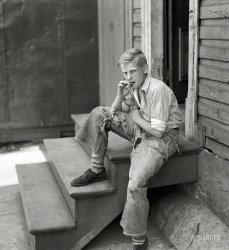
- Here's the Beef: 1941
- ... in Austin, Minnesota." Medium format acetate negative by John Vachon for the Farm Security Administration. View full size.
Non-vegan ... Posted by Dave - 03/30/2020 - 3:39pm -
![Here's the Beef: 1941 July 1941. "The beef cut. Packing plant in Austin, Minnesota." Medium format acetate negative by John Vachon for the Farm Security Administration. View full size.
Non-veganGazing hungrily at that hunk of rib on the shelf puts me in mind of the 1748 Hogarth painting "O the Roast Beef of Old England", a detail of which is provided below.
Where's the beef?Isn't this the Hormel pork plant in Austin?
[It's the Hormel meat-packing plant. - Dave]
Beef in miniature Those are the tiniest cows I've ever seen.
[Veal calves. - Dave]
Not counting sheep tonightSuggestion: don't follow Dave's link to the LoC's Hormel plant collection right before bed.
WWII -- Serving Our TroopsWith the passing of the Lend-Lease Act of 1941, Hormel Foods shipped up to 15 million cans of meat per week overseas, most of which were products from the iconic SPAM brand. By 1944, more than 90 percent of the canned foods were shipped for government use.
(The Gallery, John Vachon, Kitchens etc.)](https://www.shorpy.com/files/images/SHORPY-8c19714a.thumbnail.jpg)
- Ice Cycle: 1941
- ... till someone lets it in. Medium format acetate negative by John Vachon for the Farm Security Administration. View full size.
DANGER ... Posted by Dave - 01/14/2020 - 3:15pm -
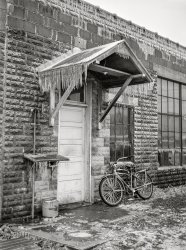
- Best Friends: 1938
- ... "Boy with dog. Omaha, Nebraska." 35mm nitrate negative by John Vachon for the Farm Security Administration. View full size.
Dog Point ... Posted by Dave - 08/02/2017 - 9:24am -
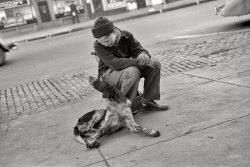
- Beauty Ress Court: 1942
- ... your choice of Coke, Pepsi or Calso. Acetate negative by John Vachon for the Farm Security Administration. View full size.
West ... Posted by Dave - 02/12/2022 - 8:14pm -
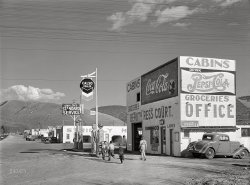
- Beer Here: 1937
- ... rounds, you can get a haircut. Medium-format negative by John Vachon. View full size.
Clever slogan Free State was located on ... Posted by Dave - 03/25/2013 - 2:03pm -
![Beer Here: 1937 Sept. 1937. "Barber shop and pool hall. Berwyn, Maryland." Between rounds, you can get a haircut. Medium-format negative by John Vachon. View full size.
Clever sloganFree State was located on Baltimore's Hillen Street, I believe; the site is now occupied by a Baltimore fire house. Their slogan was one of the neatest going: "Your Thirst Choice". Unfortunately for them, their beer WASN'T Baltimore's first choice [or second or fourth...].
Shaefer took over Gunther's and dropped the name, dropped the recipe and thought Baltimoreans would flock to Shaefer. It didn't happen.
Globe Brewing had a lineage dating back to the late 18th Century.
All gone todayArrow Beer was a brand of Baltimore's Globe Brewing and lasted until 1963. Gunther Beer merged with Schaefer around the same time, with the Baltimore facility lasting about another decade. Free State closed in 1952; there is now a popular Kansas microbrewery of the same name but I don't believe they are related.
I Wondered What The Good Head Was OnNow we know.
I only need a shave.Make mine a shorty and a shot.
Handled CorrectlyYou could stay there forever. No need to go home.
Trolley Tripper?With one or two transfers John Vachon could have easily traveled from his Rosslyn, VA photo locations to this one. Most of Berwyn's business district was within a block or so of the trolley line. In fact, I have a dim memory of my dad and I visiting a barber shop there in the 50's that sat right next to the track.
Old Hopfheiser (Hop-Hi-Zer)Hopfheiser Beer was contract brewed for a distributor in the Washington, DC area by the Globe Brewing Co.
The beers may be gone, butThe building lives on at 5000, 5002 and 5004 Berwyn Road, Berwyn Heights. Berwyn Road is of of US Route 1 just north of the University of Maryland.
Short walk to trolleyThe trolley ran on what is now the College Park Trolley Trail that is approximately 50 yards away. The correct current address is 5002 and 5004. 5000 is corner building not pictured in Vachon image.
Growing up a GuntherGrowing up in Baltimore with the last name of Gunther could be hazardous. I was always subject to any juvenile humor that would turn around a jingle to my disadvantage.
The ad in the comment below was before my time thankfully but I still remember being playfully taunted by my friends whenever a new campaign would roll out. My bearing the brunt of the jibes was finally paid off when in 1954 the Baltimore Orioles came to the American League and Gunther became their TV sponsors and out in left field was a big scoreboard with my last name along the bottom.
(The Gallery, Eateries & Bars, John Vachon)](https://www.shorpy.com/files/images/SHORPY_8b31483a.thumbnail.jpg)
- A Sign: 1941
- ... Ohio. "Jewelers sign." 35mm nitrate negative by John Vachon for the Farm Security Administration. View full size.
The stuff ... Posted by Dave - 11/15/2011 - 7:48am -
![A Sign: 1941 October 1941. Chillicothe, Ohio. "Jewelers sign." 35mm nitrate negative by John Vachon for the Farm Security Administration. View full size.
The stuff that dreams are made ofJust the thing Spade or Marlowe would see from his office window.
Mis-spelling?Null points for spelling - both you and the sign maker - Jeweller surely?
[In American English, "jeweler" has but one L. - Dave]
Little light bulbsIt must have been a major job keeping signs illuminated in the pre-neon days. Now even neon is passe -- being replaced by LEDs (Light Emitting Diodes).
[Neon -- replaced ages ago by fluorescent backlight signage -- is actually quite chic these days. - Dave]
Yes, I never liked fluorescent back-lit signs, they are bland, boring. Neon was more colorful and can be animated. LEDs are more colorful and animateable yet- and can create infinite designs and even pictures.
Cool sign, cool photoI think John Vachon took by far the most interesting photographs of anyone from the FSA.
De-signsSome of these signs were pretty cleverly designed. The garage sign below is one of my favorites. It sold for $34,500 at auction last year.
(The Gallery, John Vachon)](https://www.shorpy.com/files/images/SHORPY_8a32596a.thumbnail.jpg)
- Little Sipper: 1942
- ... borrower, giving her daughter a glass of milk." Photo by John Vachon for the Farm Security Administration. View full size.
Hand me a ... Posted by Dave - 02/20/2022 - 2:37pm -
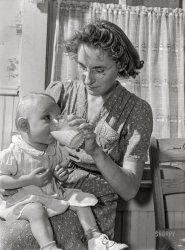
- I Walk the Line: 1941
- ... Virginia." The lady last seen here . Photo by John Vachon. View full size.
Drying clothes the old fashioned way I can ... Posted by Dave - 06/23/2020 - 8:31pm -
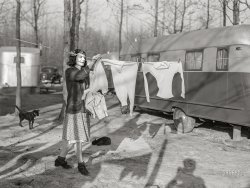
- Indian Trails Texaco: 1940
- ... in Benton Harbor, Michigan." 35mm nitrate negative by John Vachon for the Farm Security Administration. View full size.
Fully ... Posted by Dave - 08/31/2010 - 9:32pm -
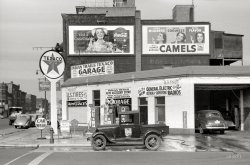
- C. City City Hall: 1942
- ... region of Central Colorado." Acetate negative by John Vachon for the Farm Security Administration. View full size.
Pretty ... might as well be tourist pockets, right?
(The Gallery, John Vachon, Small Towns) ... Posted by Dave - 02/15/2022 - 11:54am -
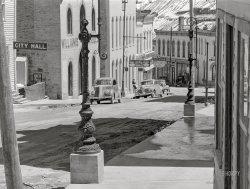
- Missoula: 1942
- ... "Missoula, Montana." Medium format acetate negative by John Vachon for the Office of War Information. View full size.
The turntable ... Posted by Dave - 10/23/2021 - 11:39am -
![Missoula: 1942 April 1942. "Missoula, Montana." Medium format acetate negative by John Vachon for the Office of War Information. View full size.
The turntable is still thereBut the buildings have gone.
https://www.google.com/maps/@46.8761404,-113.9892682,3a,60y,244.79h,95.25t/data=!3m6!1e1!3m4!1s1ReWcT0iuv0JuXq_HnvBYw!2e0!7i13312!8i6656
TurntableThe roundhouse is gone, so now we can see the turntable. However, it was not housed or sheltered. It was an open air table, like almost all of them were.
Three C's DeploymentMy dad was in this area a few years earlier with the Civilian Conservation Corps. I suspect it looked pretty much the same when he was out there.
Changed, but not totally differentThis Street View is taken from what is now Interstate 90, also called MT-200. The main body of the train station is still on the other side of the tracks but the house sheltering the turntable is gone. At left the cupola atop the Missoula County government building is still visible.
The roundhouse is gone - - but the turntable is still there and in use.
Round? Yes. House? Nope. Poor trains, nary a roof over their heads.
Spare tires?There are several piles of large rings in the foreground, to the left of the locomotive barns. Are those spare tires for the drive wheels?
The view from Waterworks HillSurviving buildings include the former Atlantic Hotel (including its wall sign), the former Northern Pacific Railroad Depot, St. Francis Xavier Catholic Church, and the Missoula County Courthouse. Vachon took this picture from "Waterworks Hill," which is getting a major upgrade (including its own parking lot) for the benefit of others using the spot to look over the City, or as a trailhead.
A bunch of balloons?Nice view of the now-gone roundhouse. Everything here is fairly recognizable except for the odd looking load in this gondola. Anybody know what this is? And there is the oddly proportioned caboose next to the gon.
[The load of logs is behind the gondola. - Dave]
The Paint on the Building ...The Atlantic Hotel and Coca Cola signs painted on the side of building located at 519 N. Higgins Ave are both still there.
Missoula StationMissoula Station is listed on the National Register of Historic Places in 1985, as the Northern Pacific Railroad Depot. Near the depot is the preserved Northern Pacific #1356 4-6-0 steam locomotive.
If you know, you knowEvery time I hear or read the words "Missoula Montana" I think of that scene in Twin Peaks where Ray Wise (as Leland Palmer) is in the process of murdering Sheryl Lee (as Maddy Ferguson, his niece) and he shoves her into a mirror bellowing "You're Going Back ... to Missoula ... MONTANAAAAAAA!"
(The Gallery, John Vachon, Landscapes, Railroads)](https://www.shorpy.com/files/images/SHORPY-8c21943a.thumbnail.jpg)
- Tattoo II: 1941
- ... Norfolk, Virginia." Medium format acetate negative by John Vachon for the Farm Security Administration. View full size.
Pick up ... Posted by Dave - 06/24/2020 - 5:12pm -
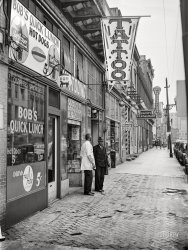
- Blowing Smoke: 1943
- ... cigarette advertisement at Times Square." Photograph by John Vachon for the Office of War Information. View full size.
Ames Billiard ... Posted by Dave - 08/01/2012 - 1:35pm -
![Blowing Smoke: 1943 February 1943. "New York. Camel cigarette advertisement at Times Square." Photograph by John Vachon for the Office of War Information. View full size.
Ames Billiard AcademyRight behind the Camel sign was Ames pool room, where parts of "The Hustler" were filmed with Paul Newman and Jackie Gleason in 1960.
Douglas Leigh Inc.Douglas Leigh, the man who designed this and other advertising spectaculars, was 28 when he arrived in New York from Alabama with $9 in his pocket. He developed a multimillion-dollar business designing and erecting breathtaking signs.
Leigh created the Super Suds detergent sign with 3,000 large "floating" soap bubbles per minute. A 120-foot Pepsi-Cola waterfall, the Bromo-Seltzer sign with actual effervescence and the Old Gold cigarettes sign with 4,100 light bulbs were all Leigh creations.
His giant Camel sign that puffed out real smoke rings lasted for 26 years on Broadway and was copied in 22 cities. He was also the brains behind the 25-foot A&P coffee cup that let off real steam.
-- From Leigh's 1999 New York Times obituary
Where are my smokes?I just love the two women in the corner digging through their purses... What might they be looking for in 1943? Money? Ticket to a show?
And the short white socks... Scotty, beam me to NYC, 1943 please!
What's in a name?"Costlier tobaccos," sounds like today's cigarettes!
Mixed MediaI adore these adverts where the object does something -- smoke or steam, movement, three-dimensional objects etc.
Signs of the TimesAh yes, the sign, the Hotel Claridge and Times Square during the war years. I remember them so well, along with Toffenetti's Restaurant, any Longchamps or Childs NY outlet, the Woodstock Hotel and, when my family was flush, the Hotel Taft and the Roxy Theater. Camels were hard to come by for civilians during the war. My dad resorted to rolling his own using Model smoking tobacco and one of those hand-operated machines.
All those bulbs!I would love to see a picture of this sign at nighttime. With all those lightbulbs, I bet you could see it from the moon.
Very LifelikeDoes it cough and wheeze?
OverlapI wonder what the neon over the top of the words "Costlier Tobacco" would say when lit? It looks like it can be turned on and off to make different slogans.
Shorpy window peepers.I just love how many Shorpy images have someone looking out a window! The hotel window above the M in Camel has a shadowy face and a hand holding the curtain back.
[That's Ima Lamp. Not much of a talker, but she really lit up a room. - Dave]
Big smokeWhen I was about 12 or 13 years old in 1952, I went with my siblings, stepfather and mother on a trip to New York City and walked directly beneath the sign. I was amazed at how large it was. The tube blowing the "smoke" was probably a good 2 to 3 feet across. That scale doesn't show up well in photos.
What a dumpNo one's noticed Bette Davis crossing the street?
Slower BurningOne of the neon sign slogans apparently was "Slower Burning"
http://www.si.edu/opa/insideresearch/photo_pages/V17_TimesSquare_smokeri...
And "I'd walk a mile for a Camel"
http://www.panoramio.com/photo/19461756
I'd Walk a MileBoth my parents smoked Camels. My dad switched to cigars around 1960, he died in 1963. My mom smoked 'em until she died in 1985.
My mom told me that during the war she had to smoke a cheap brand called Marvels because Camels were hard to come by. Apparently cigarettes weren't rationed, but most of the cigarette production was shipped to our troops.
Nicotine NostalgiaMy old German father rolled his own cigarettes which he smoked six days a week. However . . . Camels on Sundays!
Remember the Leave it to Beaver episode where Beaver & Larry Mondello climb up on a big sign? I think it was steaming tea.
When I was a kid......my mom told me that there were 20 guys in a room behind the sign smoking cigarettes. At the appointed time, they would all exhale and blow their smoke through the hole.
T'was trueMost of the cigarette production during WWII went to troops overseas. It's the wrong brand, but many should remember the marketing cry, "Lucky Strike Green Went to War." Today's familiar Lucky Strike pack came into being in stores as Green was shipped off to far-flung battlegrounds. Regarding that steamy Camel sign: My brother and I often sidled by it in the 50s, and would wait for the "smoke" to puff out at traffic. I think we thought it was smoke, not steam. I've often wondered if such friendly advertising contributed to my 20 year habit and my brother's 35 year habit. Alas.
The Camel SignIt's interesting, I found a number of images of this billboard online. The structure of the puffing billboard remained the same, just the smoker was repainted over and over again.
1941(?)
1943
1944
1945 (film of billboard in action. Opens in your media player)
1964
1965
Time to Go"Lucky Strike Green has gone to war". There was an untold story behind that, which has been told (about ten years ago) in a book called The Father of Spin.
The CEO of whichever company made Luckies contacted Edward S. Bernays in 1932 because he had a problem. He wanted more women to smoke his cigarettes, but they told him they wouldn't buy Luckies because the green clashed with their clothing. Bernays suggested changing the package color, but the exec wouldn't hear of it. So Bernays set about influencing public opinion to make green a "fashionable" color.
He organized an elaborate clandestine PR campaign (Bernays more or less invented PR), to get tastemakers to glom on to the green idea. It worked in the sense that green temporarily became a fashionable color that year, but it didn't move the sales of Luckies by much, and certainly not in a sustainable manner.
If you know that story, it doesn't take much to connect the dots and see that the war was the perfect excuse to get rid of the offending green. Never mind that many folks at the time expressed outrage at a tobacco company's crass claim of "sacrifice," when many were sacrificing much more than a package design.
(The Gallery, John Vachon, NYC)](https://www.shorpy.com/files/images/8d14368u1.thumbnail.jpg)
- Aberdeen: 1940
- ... settled by Easterners." Medium format acetate negative by John Vachon. View full size.
Be it ever so humble. There's no place like ... Posted by Dave - 08/06/2021 - 9:08am -
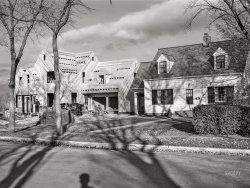
- Nice Tie: 1941
- ... will be displaced." Medium format acetate negative by John Vachon for the Farm Security Administration. View full size.
Honest six ... Posted by Dave - 06/12/2020 - 1:56pm -
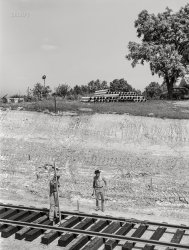
- Lunch Beer Candy: 1940
- ... in Lexington, Kentucky." Medium format acetate negative by John Vachon for the Farm Security Administration. View full size.
Still ... Posted by Dave - 01/12/2022 - 9:06pm -
![Lunch Beer Candy: 1940 November 1940. "Corner store in Lexington, Kentucky." Medium format acetate negative by John Vachon for the Farm Security Administration. View full size.
Still standing, but ...Hard to believe, but this building and the present structure at this site are one and the same. It was heavily "modernized" in the mid-20th century, probably after a fire. Now a popular neighborhood bar. I've been in there many times.
[Amazing! - Dave]
History in the basementThis reminds me of a neat example of how buildings evolve. A couple of years ago the owners of the bar did a major interior remodel that involved removing the floor, exposing the unfinished basement and original stone foundation. The electric water heater was oddly located along the outside basement wall, far from the kitchen or any other plumbing. Taking a look at the 1940 photo, it totally makes sense: the water heater would have been originally gas-fired and vented through the now-gone chimney. When the building was reconstructed and the heater replaced with an electric unit they probably saw no need to go to the expense of relocating it to a more logical place (which, in fact, the new owners finally did in their 2019 remodel).
Make mine a [root] beer floatI'm glad Steve Lexington knows the history of this building.
John Vachon captured so much here, from the texture of the brick streets to the swarm of power and phone lines overhead. The building in the 1940 photo has lots of charm; but I also like the musicians' mural on the building now. And I really like the 1940 guy walking around the corner -- from his aviator's cap with the earflaps secured to the knickers without boots or even knee-high socks. He is a fashion slave to no one.
Mystery Solved --Is that Amelia Earhart popping in for some lunch? Beer? Candy?
Oertles '92 - My Dad's Choice.Back in the '50s we lived in Louisville. My dad, descended from a line of brewers, only kept Oertles '92 in the house. He said it tasted like the beers his grandfather brewed. All I know is that it was the first beer that I tasted as a young child. I always got one sip anytime dad poured himself a cold one.
One stop shopLunch, Beer, Candy -
- My three basic food groups!
(The Gallery, Eateries & Bars, John Vachon, Small Towns, Stores & Markets)](https://www.shorpy.com/files/images/SHORPY-8c18409a.thumbnail.jpg)
- Look Downward Angle: 1941
- ... in Chicago at 9:37. Medium format acetate negative by John Vachon for the Farm Security Administration. View full size.
Bombs ... Posted by Dave - 02/05/2020 - 11:57am -
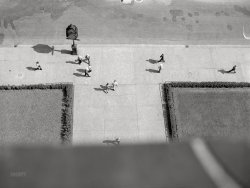
- The Big Store: 1942
- ... County, Minnesota." Medium format acetate negative by John Vachon for the Office of War Information. View full size.
... This picture is what it felt like.
(The Gallery, John Vachon, Small Towns, Stores & Markets) ... Posted by Dave - 10/17/2021 - 3:00pm -
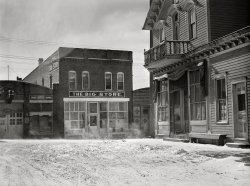
- Mad Men: 1943
- ... York, New York. Madison Avenue on a rainy day." Photo by John Vachon for the Office of War Information. View full size.
So evocative ... Posted by Dave - 07/16/2014 - 10:19am -
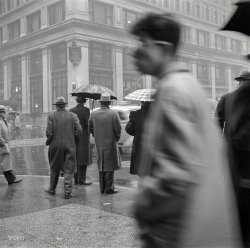
- Four O'Clock Shadow: 1941
- ... getting out at 4 p.m." Medium format acetate negative by John Vachon. View full size.
Made this crossing many times I used to work ... Posted by Dave - 06/11/2020 - 11:54am -
![Four O'Clock Shadow: 1941 March 1941. "Newport News, Virginia. Shipyard employees getting out at 4 p.m." Medium format acetate negative by John Vachon. View full size.
Made this crossing many timesI used to work NNSYDDC back in 1985-'87 and made this crossing many times, but the trolley was long gone by then. I'm sure with WWII right around the corner, that rush crowd would have been like human soup.
[WW2 and the U.S. Government's Emergency Shipbuilding Program were already well underway by March 1941, which is why John Vachon was assigned to take these photos. - Dave]
Those leaping Rams on their hoodsIdentify two Dodges, the one on the left practically new from 1940 and the one on the right from the mid-'30s with its still fabric roof center. The middle car is just a Chevrolet.
In one hourthese men will be removing the dreaded five o'clock shadow. (Was it the Gillette Blue Blades jingle that I can't get out of my head?)
(The Gallery, Cars, Trucks, Buses, John Vachon, Streetcars)](https://www.shorpy.com/files/images/SHORPY-8c19108a.thumbnail.jpg)
- A Late Start: 1940
- ... Cavalier County, North Dakota." 35mm nitrate negative by John Vachon. View full size.
Evolving Automotive Design Though this ... Posted by Dave - 02/02/2012 - 5:33pm -
![A Late Start: 1940 October 1940. "Oldest Sauer boy cranking family car. Cavalier County, North Dakota." 35mm nitrate negative by John Vachon. View full size.
Evolving Automotive Design Though this handsome big sedan was likely a model from about 1928-32, it sure looked very different from the "new" 1940 cars; nowadays a ten or twelve year old car much more closely resembles the 2012 models.
The Car1928-29 Dodge Victory Six.
SpinmeisterLooks like that kid knows what he's doing, as he appears to be pulling on that crank instead of pushing -- one of two precautions necessary to avoid a broken arm/wrist should the engine kick back. The other precaution was to grasp the crank so as to keep the thumb on the same side of the handle as the fingers.
Incidentally, emergency cranks are still supplied with small marine diesel engines. At least one model, made in Japan, carries a warning label: "Adult males only! Women and children not allowed!"
The trunkNow I know why they call it that.
My oh myit really is flat in North Dakota, I think I can see Moose Jaw across the border.
Watchful dogHe's keeping an eye on any oncoming traffic.
A Late Start: 1940There are 14 other photos of the family that were taken by John Vachon, but none gave the first names of any of the family members. My research indicates clearly that the father in the truck was Peter Sauer, and the son was Clarence Sauer. Clarence died in Cavalier County is 2006. I talked to the widow of one of Clarence's brothers. She didn't know about the photos. She is going to get me in touch with one of Clarence's sisters, who is in at least one of the other photos.
[The number of photos is at least 25, including many not in this gallery that don't have captions. For example, three other photos of this car. - Dave]
Sauer is a familiar name.....I grew up with a family of Sauers who lived around and in the towns of Carpio and Foxholm North Dakota. I wonder if they are related to the Sauer pictured in this photograph?
(The Gallery, John Vachon, Rural America)](https://www.shorpy.com/files/images/SHORPY_8a32547a.thumbnail.jpg)
- Porksicle: 1940
- ... loan from the Farm Security Administration." Photo by John Vachon. View full size.
Body shop "My Pig has Been in an accident ... Posted by Dave - 12/05/2019 - 6:46pm -
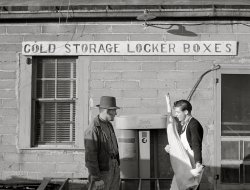
- Sky Chief: 1942
- ... and grain elevator." Medium format acetate negative by John Vachon for the Farm Security Administration. View full size.
Die and ... Posted by Dave - 02/23/2022 - 1:22pm -
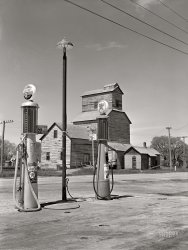
- St. Louis: 1940
- ... of Union Station, St. Louis, Missouri." 35mm negative by John Vachon for the Farm Security Administration. View full size.
St. Louis ... Posted by Dave - 07/18/2011 - 10:44am -
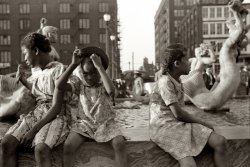
- Hotel Fontenelle: 1938
- ... of Omaha, Nebraska." Medium format acetate negative by John Vachon for the Farm Security Administration. View full size.
Gone by ... Posted by Dave - 08/07/2020 - 1:18pm -
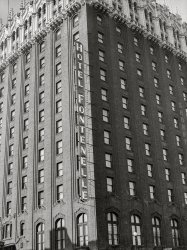
- Kewpee Panorama: 1940
- ... Harbor, Michigan." This composite of two photos taken by John Vachon features "Kewpee Hamburgs" ( last seen here ) on the left; the ... Posted by Dave - 12/28/2019 - 10:44am -
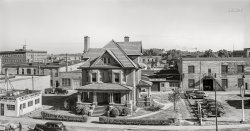
- Fresh Tracks: 1941
- ... Hibbing, Minnesota." Medium format acetate negative by John Vachon for the Farm Security Administration. View full size.
How to ... Posted by Dave - 02/24/2020 - 2:21pm -
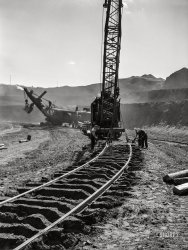
- Frozen Motors: 1942
- ... Montana. Used car lot." Medium format acetate negative by John Vachon for the Office of War Information. View full size.
Zero degrees ... Posted by Dave - 11/24/2021 - 11:38am -
